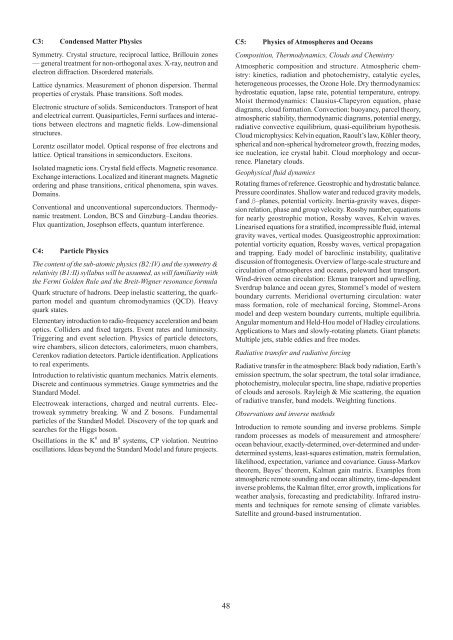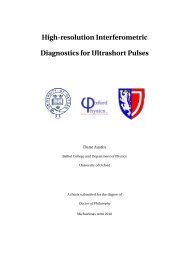Undergraduate Course Handbook - University of Oxford Department ...
Undergraduate Course Handbook - University of Oxford Department ...
Undergraduate Course Handbook - University of Oxford Department ...
Create successful ePaper yourself
Turn your PDF publications into a flip-book with our unique Google optimized e-Paper software.
C3: Condensed Matter PhysicsSymmetry. Crystal structure, reciprocal lattice, Brillouin zones— general treatment for non-orthogonal axes. X-ray, neutron andelectron diffraction. Disordered materials.Lattice dynamics. Measurement <strong>of</strong> phonon dispersion. Thermalproperties <strong>of</strong> crystals. Phase transitions. S<strong>of</strong>t modes.Electronic structure <strong>of</strong> solids. Semiconductors. Transport <strong>of</strong> heatand electrical current. Quasiparticles, Fermi surfaces and interactionsbetween electrons and magnetic fields. Low-dimensionalstructures.Lorentz oscillator model. Optical response <strong>of</strong> free electrons andlattice. Optical transitions in semiconductors. Excitons.Isolated magnetic ions. Crystal field effects. Magnetic resonance.Exchange interactions. Localized and itinerant magnets. Magneticordering and phase transitions, critical phenomena, spin waves.Domains.Conventional and unconventional superconductors. Thermodynamictreatment. London, BCS and Ginzburg–Landau theories.Flux quantization, Josephson effects, quantum interference.C4: Particle PhysicsThe content <strong>of</strong> the sub-atomic physics (B2:IV) and the symmetry &relativity (B1:II) syllabus will be assumed, as will familiarity withthe Fermi Golden Rule and the Breit-Wigner resonance formulaQuark structure <strong>of</strong> hadrons. Deep inelastic scattering, the quarkpartonmodel and quantum chromodynamics (QCD). Heavyquark states.Elementary introduction to radio-frequency acceleration and beamoptics. Colliders and fixed targets. Event rates and luminosity.Triggering and event selection. Physics <strong>of</strong> particle detectors,wire chambers, silicon detectors, calorimeters, muon chambers,Cerenkov radiation detectors. Particle identification. Applicationsto real experiments.Introduction to relativistic quantum mechanics. Matrix elements.Discrete and continuous symmetries. Gauge symmetries and theStandard Model.Electroweak interactions, charged and neutral currents. Electroweaksymmetry breaking. W and Z bosons. Fundamentalparticles <strong>of</strong> the Standard Model. Discovery <strong>of</strong> the top quark andsearches for the Higgs boson.Oscillations in the K 0 and B 0 systems, CP violation. Neutrinooscillations. Ideas beyond the Standard Model and future projects.C5: Physics <strong>of</strong> Atmospheres and OceansComposition, Thermodynamics, Clouds and ChemistryAtmospheric composition and structure. Atmospheric chemistry:kinetics, radiation and photochemistry, catalytic cycles,heterogeneous processes, the Ozone Hole. Dry thermodynamics:hydrostatic equation, lapse rate, potential temperature, entropy.Moist thermodynamics: Clausius-Clapeyron equation, phasediagrams, cloud formation. Convection: buoyancy, parcel theory,atmospheric stability, thermodynamic diagrams, potential energy,radiative convective equilibrium, quasi-equilibrium hypothesis.Cloud microphysics: Kelvin equation, Raoult’s law, Köhler theory,spherical and non-spherical hydrometeor growth, freezing modes,ice nucleation, ice crystal habit. Cloud morphology and occurrence.Planetary clouds.Geophysical fluid dynamicsRotating frames <strong>of</strong> reference. Geostrophic and hydrostatic balance.Pressure coordinates. Shallow water and reduced gravity models,f and –planes, potential vorticity. Inertia-gravity waves, dispersionrelation, phase and group velocity. Rossby number, equationsfor nearly geostrophic motion, Rossby waves, Kelvin waves.Linearised equations for a stratified, incompressible fluid, internalgravity waves, vertical modes. Quasigeostrophic approximation:potential vorticity equation, Rossby waves, vertical propagationand trapping. Eady model <strong>of</strong> baroclinic instability, qualitativediscussion <strong>of</strong> frontogenesis. Overview <strong>of</strong> large-scale structure andcirculation <strong>of</strong> atmospheres and oceans, poleward heat transport.Wind-driven ocean circulation: Ekman transport and upwelling,Sverdrup balance and ocean gyres, Stommel’s model <strong>of</strong> westernboundary currents. Meridional overturning circulation: watermass formation, role <strong>of</strong> mechanical forcing, Stommel-Aronsmodel and deep western boundary currents, multiple equilibria.Angular momentum and Held-Hou model <strong>of</strong> Hadley circulations.Applications to Mars and slowly-rotating planets. Giant planets:Multiple jets, stable eddies and free modes.Radiative transfer and radiative forcingRadiative transfer in the atmosphere: Black body radiation, Earth’semission spectrum, the solar spectrum, the total solar irradiance,photochemistry, molecular spectra, line shape, radiative properties<strong>of</strong> clouds and aerosols. Rayleigh & Mie scattering, the equation<strong>of</strong> radiative transfer, band models. Weighting functions.Observations and inverse methodsIntroduction to remote sounding and inverse problems. Simplerandom processes as models <strong>of</strong> measurement and atmosphere/ocean behaviour, exactly-determined, over-determined and underdeterminedsystems, least-squares estimation, matrix formulation,likelihood, expectation, variance and covariance. Gauss-Markovtheorem, Bayes’ theorem, Kalman gain matrix. Examples fromatmospheric remote sounding and ocean altimetry, time-dependentinverse problems, the Kalman filter, error growth, implications forweather analysis, forecasting and predictability. Infrared instrumentsand techniques for remote sensing <strong>of</strong> climate variables.Satellite and ground-based instrumentation.48









![Extended Notes 8 [pdf]](https://img.yumpu.com/50123548/1/190x245/extended-notes-8-pdf.jpg?quality=85)




![Handout 3 [pdf] - University of Oxford Department of Physics](https://img.yumpu.com/46475432/1/190x245/handout-3-pdf-university-of-oxford-department-of-physics.jpg?quality=85)